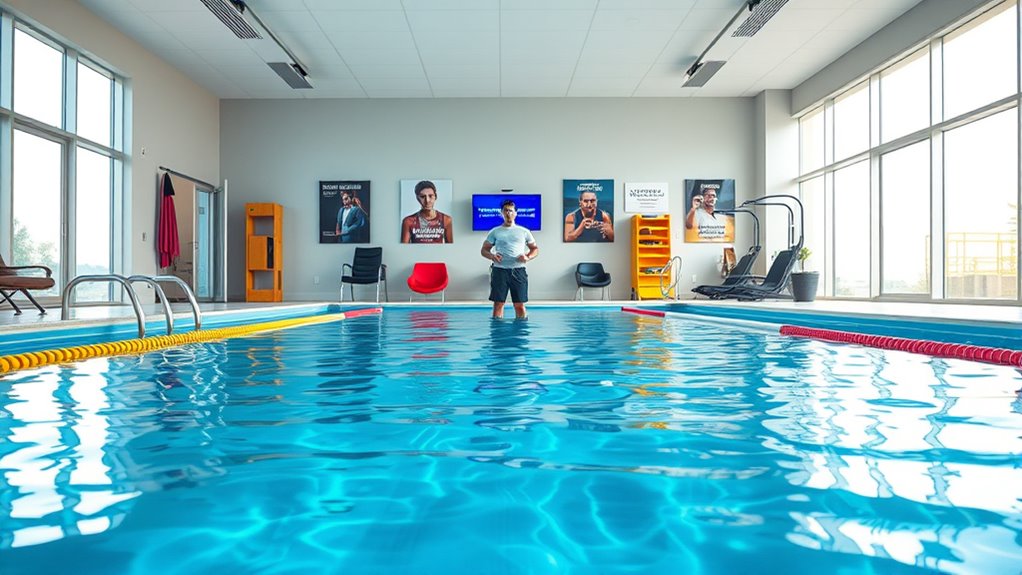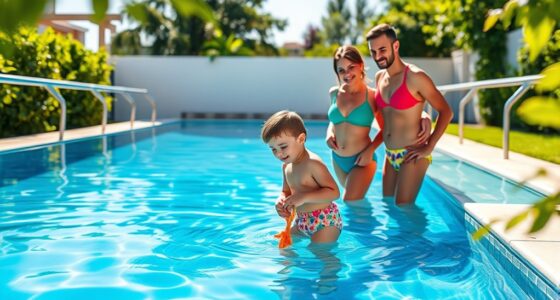To shift from rehab to sport using Endless Pool protocols, focus on evaluating your readiness with advanced technology like wearable sensors to monitor movement and strength. Develop a personalized water-based program that incorporates resistance, balance, and sport-specific drills tailored to your injury and goals. Progress gradually with real-time adjustments, tracking cardiovascular fitness and proprioception. Stay motivated and confident as you build strength and coordination—your pathway to a safe return begins with leveraging these proven strategies; explore further details to maximize your recovery.
Key Takeaways
- Utilize water-based resistance exercises to progressively rebuild strength and stability in a low-impact environment.
- Incorporate sport-specific drills in the pool to enhance neuromuscular control and confidence for return-to-sport.
- Monitor cardiovascular conditioning through aquatic activities like water walking and swimming to ensure safe endurance recovery.
- Adjust water resistance and exercise intensity in real-time based on objective performance and patient feedback.
- Use balance and proprioception exercises in the pool to improve stability and prevent re-injury during sport re-entry.
Assessing Athlete Readiness With Technology
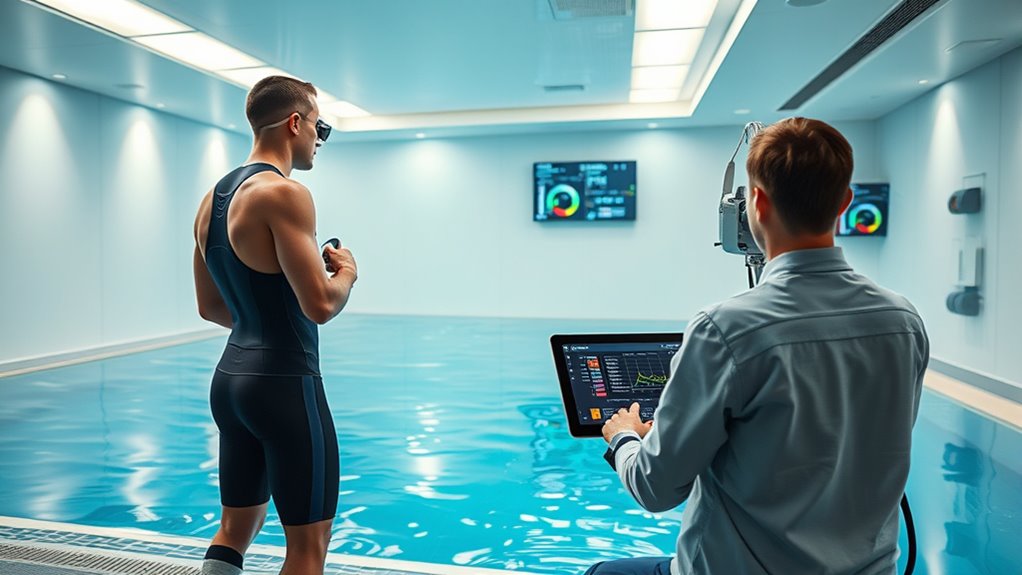
Evaluating athlete readiness with technology has become a critical step in modern rehab protocols. You can now use advanced tools like wearable sensors and motion analysis systems to objectively measure progress. These devices track movement patterns, joint angles, and muscle activation, providing real-time data that helps you determine if an athlete is ready to advance. Technology eliminates guesswork, offering precise insights into strength, stability, and coordination. For example, pressure sensors can assess balance and weight distribution, while motion capture highlights asymmetries or compensations. By integrating these tools, you gain a thorough view of recovery, ensuring athletes meet specific criteria before progressing. Additionally, understanding the impact of contrast ratio and color accuracy can enhance visual feedback in virtual rehab environments, further supporting athlete assessment. This approach increases safety, reduces re-injury risk, and streamlines the decision-making process during rehab.
Designing Personalized Water-Based Rehabilitation Programs
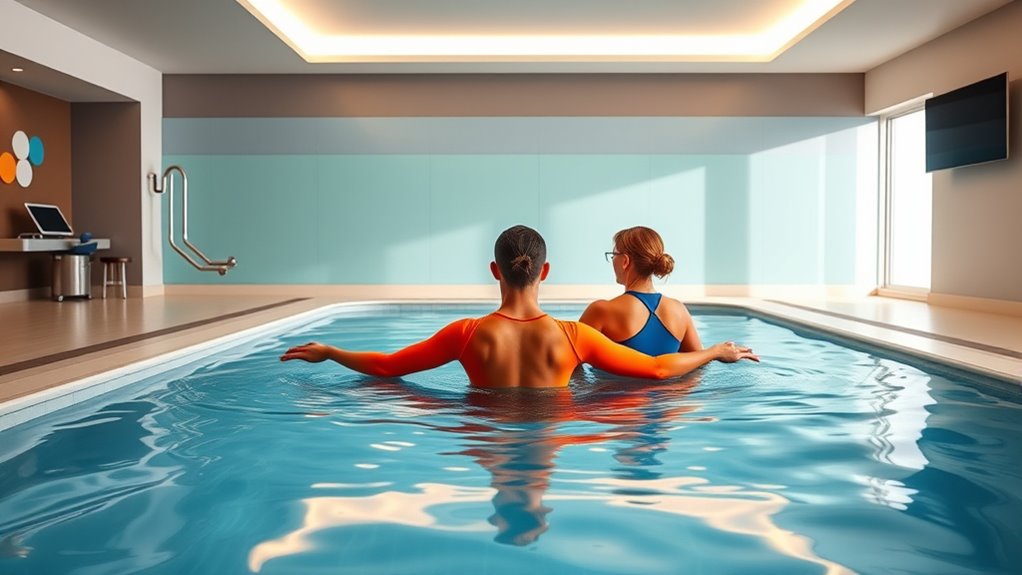
When designing water-based rehab programs, you focus on creating personalized plans tailored to each athlete’s needs. You incorporate adaptive water exercises that challenge and support recovery while monitoring progress carefully. This targeted approach helps guarantee safe, effective, and efficient return-to-sport readiness. Incorporating visual and audio feedback from arcade machines can also enhance engagement and motivation during rehabilitation sessions.
Individualized Program Development
Designing personalized water-based rehabilitation programs requires careful consideration of each individual’s unique injury, fitness level, and recovery goals. You need to assess the severity of the injury, noting any limitations or restrictions, and tailor exercises accordingly. Understanding the patient’s baseline fitness helps determine appropriate intensity and duration of sessions. Set clear, achievable goals that align with the individual’s desired return-to-sport timeline. Incorporate variety in exercises to target specific muscles and movement patterns, ensuring progressive overload as recovery advances. Regularly monitor progress and adjust the program to address changes in strength, flexibility, and endurance. This tailored approach maximizes healing, minimizes setbacks, and promotes confidence, ultimately guiding you efficiently back to full activity with reduced risk of re-injury.
Adaptive Water Exercises
How can you create water-based rehabilitation programs that adapt to each individual’s needs? The key is tailoring exercises to match the patient’s unique injury, strength level, and mobility. Use adjustable water depths, resistance levels, and exercise intensities to customize the program. Incorporate a variety of activities, such as walking, jogging, or resistance training, to target specific muscle groups and joint mechanics. Pay attention to how the patient responds, and modify the exercises accordingly. Adaptive water exercises allow for gradual progression, reducing the risk of re-injury while building confidence. By closely monitoring responses and adjusting parameters, you guarantee each session remains challenging yet safe. Incorporating professional voice techniques can enhance instruction clarity and patient motivation. This personalized approach maximizes recovery efficiency and prepares your patient for a successful return to sport.
Progress Monitoring Strategies
Effective progress monitoring is essential to tailoring water-based rehabilitation programs to each patient’s evolving needs. By regularly assessing performance, you can identify improvements, plateaus, or setbacks early. Use objective measures like range of motion, strength tests, and functional tasks to track progress. Incorporate patient feedback on pain levels, confidence, and perceived exertion to gain a comprehensive understanding of their recovery. Adjust exercises, intensity, and duration based on these insights to guarantee ideal challenge without risking overexertion. Consistent documentation helps you recognize patterns and modify protocols accordingly. This ongoing evaluation keeps the program personalized, promotes motivation, and guarantees a safe, efficient transition back to sport. Additionally, understanding anime culture and storytelling can enrich your approach to engaging patients through motivational narratives. Ultimately, targeted progress monitoring maximizes rehabilitation outcomes and accelerates the return-to-sport process.
Incorporating Cardiovascular Conditioning for Full-Body Recovery

To support full-body recovery, incorporating low-impact cardio options helps build endurance without overstressing your joints. Using progressive intensity strategies guarantees your cardiovascular conditioning advances safely alongside your rehab progress. Monitoring recovery metrics keeps you on track and allows adjustments to optimize your return-to-sport plan. Incorporating sustainable practices into your recovery routine can also promote overall well-being and long-term health benefits.
Low-Impact Cardio Options
Incorporating low-impact cardio options into your rehab program is essential for gradually rebuilding cardiovascular endurance without stressing injured tissues. These exercises help you maintain activity levels while minimizing joint and tissue strain. Using equipment like an Endless Pool allows you to perform gentle, controlled movements that support full-body recovery. Consider options such as walking in water, cycling on a stationary bike, or swimming with minimal resistance. These activities improve circulation, support tissue healing, and boost overall fitness. Here’s a quick comparison:
| Activity | Benefits | Ideal For |
|---|---|---|
| Water walking | Reduced joint impact, full-body workout | Early rehab stages |
| Stationary cycling | Low-impact, controlled intensity | Mid-recovery phase |
| Swimming | Gentle resistance, full-body engagement | Advanced rehab, return-to-sport prep |
Adding cardiovascular conditioning with these low-impact activities enhances recovery by promoting circulation and tissue repair while minimizing stress on injured areas.
Progressive Intensity Strategies
Building on your low-impact cardio work, gradually increasing the intensity of your exercises helps restore full-body cardiovascular fitness. You can do this by adding short bursts of higher effort within your routine or extending your workout duration. For example, after steady-paced swimming, incorporate brief intervals of faster strokes or increased resistance. As your endurance improves, challenge yourself with more demanding sets, such as faster laps or increased water resistance. This progressive approach guarantees your body adapts safely without overloading healing tissues. Focus on maintaining proper technique as you ramp up intensity, avoiding sudden jumps that could cause setbacks. Consistent, incremental increases in effort help rebuild your cardiovascular capacity and prepare your body for the demands of return-to-sport activities.
Monitoring Recovery Metrics
Monitoring recovery metrics is essential to guarantee your cardiovascular conditioning progresses safely and effectively. Tracking key indicators helps you adjust intensity and avoid overexertion, ensuring a smooth return to full-body activity. Focus on metrics like heart rate, perceived exertion, and recovery time after workouts. Use the table below to understand the significance of these measures:
| Metric | Why It Matters |
|---|---|
| Heart Rate | Indicates workout intensity and recovery status |
| Perceived Exertion | Helps gauge subjective effort during activity |
| Recovery Time | Shows how quickly your body returns to baseline |
| Heart Rate Variability | Reflects autonomic nervous system health |
| Blood Pressure | Monitors cardiovascular response during rehab |
Consistently monitoring these metrics ensures your cardiovascular system is adapting safely, reducing the risk of setbacks. Recognizing the horsepower of electric dirt bikes can also help tailor your rehabilitation intensity, especially if you’re incorporating powered exercise equipment into your routine.
Utilizing Variable Resistance for Gradual Strength Building

Utilizing variable resistance during rehabilitation allows you to gradually increase strength by matching resistance levels to your current capabilities. This approach guarantees you aren’t overwhelmed early on and can build confidence as you progress. By adjusting resistance in real-time, you target specific muscle groups effectively and safely. This method also promotes proper movement patterns, reducing injury risk. As your strength improves, you can incrementally increase resistance to challenge yourself further. The key is consistency and listening to your body’s responses. Incorporating state tax implications into your planning can also help optimize your overall recovery and retirement strategy.
Enhancing Proprioception and Balance in the Pool

Exercising in the pool offers an ideal environment for enhancing proprioception and balance, thanks to the supportive and resistance-rich water. The water creates gentle instability, challenging your sensory system and improving your body’s awareness of position and movement. You can perform single-leg stands, balance reaches, or dynamic shifts to activate stabilizing muscles. Incorporate movements that require you to maintain control while reacting to water resistance. Use the table below to visualize different exercises and their focus areas:
| Exercise | Focus |
|---|---|
| Single-leg stand in shallow water | Static balance |
| Water-based balance reaches | Dynamic proprioception |
| Gentle resistance shifts | Stabilizer muscle engagement |
Additionally, engaging in these water-based activities can support Biodiversity by promoting movement and healthy physical activity in aquatic environments.
Integrating Sport-Specific Drills for Functional Recovery

Building on improvements in proprioception and balance gained through pool exercises, incorporating sport-specific drills helps translate this progress into functional performance. By practicing movements that mimic your sport, you reinforce neuromuscular control and build confidence for return-to-play. Focus on drills that replicate key actions, such as cutting, jumping, or pivoting, while maintaining proper form. These exercises should challenge your stability and coordination without risking re-injury. Gradually increase intensity and complexity as your strength improves. This targeted approach guarantees your body adapts to sport demands, making your transition safer and more effective. Incorporate functional movement patterns to enhance the relevance of your training and ensure seamless integration into your sport.
Monitoring Progress and Adjusting Protocols in Real-Time

Monitoring your progress during rehabilitation allows you to make timely adjustments that keep you on track for a safe return to sport. By paying close attention to how your body responds during each session, you can identify signs of improvement or areas needing extra focus. Use objective data, like range of motion, strength measurements, and pain levels, to guide your decisions. If certain exercises cause discomfort or plateau, modify or replace them to prevent setbacks. Regular check-ins with your therapist or trainer help you interpret progress accurately. This real-time feedback loop ensures your protocols stay personalized and effective, preventing overtraining or undertraining. Staying vigilant about your progress empowers you to make informed choices, optimizing recovery and reducing the risk of reinjury.
Building Confidence and Psychological Readiness
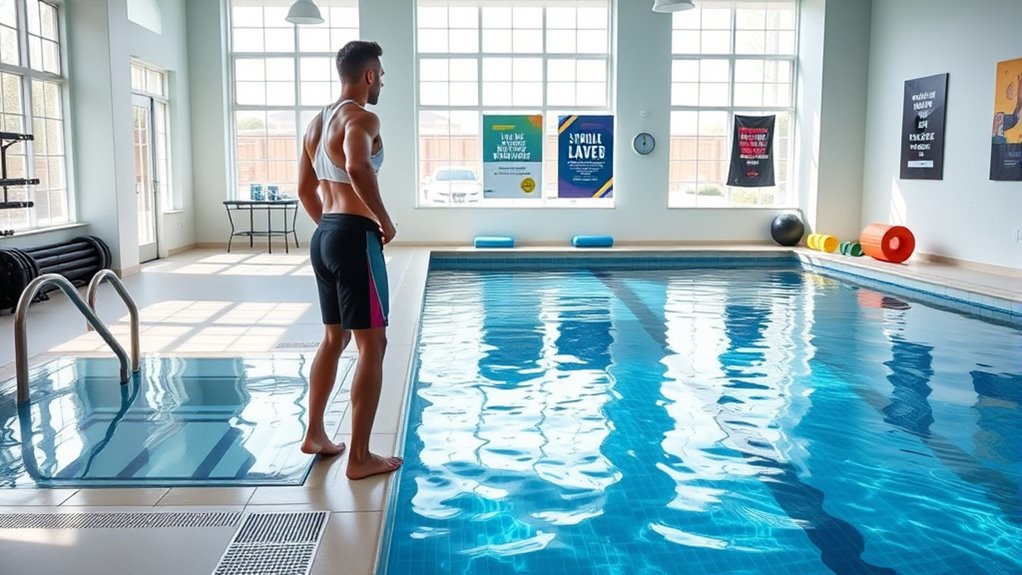
Achieving psychological readiness is a essential step in confidently returning to sport after injury. You need to believe in your ability to perform safely and trust your body’s recovery. Building confidence involves setting small, achievable goals that demonstrate progress and foster a sense of control. Visualizing successful performance can also boost mental preparedness. Surrounding yourself with supportive coaches and teammates helps reinforce positive mindset and motivation. Remember, addressing fears and anxieties openly is fundamental for mental resilience. Incorporate mindfulness and relaxation techniques to reduce stress and stay focused. By actively engaging in these strategies, you’ll develop a stronger mental foundation to re-enter your sport with confidence.
Achieving psychological readiness boosts confidence, trust, and resilience for a safe return to sport after injury.
- Setting achievable milestones
- Visualization and mental imagery
- Seeking support from coaches and teammates
- Practicing mindfulness and stress reduction
Transitioning Back to Land-Based Training Safely

After establishing your confidence and mental readiness, safely returning to land-based training marks a pivotal step in your recovery process. Start gradually, integrating low-impact activities like walking or gentle jogging to reintroduce your body to weight-bearing movements. Focus on proper technique to prevent injury and listen closely to your body’s signals. Incorporate balance and stability exercises to rebuild strength and coordination. Use supportive footwear and consider using assistive devices if needed. Progressively increase intensity and duration as your comfort and strength improve. Regularly consult with your healthcare or rehabilitation team to guarantee you’re on the right track. Patience is key—rushing this phase can set back your recovery. By taking careful, deliberate steps, you’ll transition safely and set a solid foundation for returning to full land-based training.
Frequently Asked Questions
How Long Should an Athlete Typically Stay in Water-Based Rehab Before Returning to Sport?
You should typically stay in water-based rehab until you regain full strength, range of motion, and confidence in your movements, which can take anywhere from a few weeks to a couple of months depending on your injury. It’s important to listen to your healthcare team’s guidance, progress gradually, and make certain you can perform sport-specific tasks without pain or instability. Rushing back too soon increases the risk of re-injury.
What Are Common Pitfalls When Transitioning From Aquatic to Land-Based Training?
You might struggle with shifting if you rush the switch from aquatic to land-based training. Common pitfalls include overloading joints too soon, neglecting neuromuscular control, and ignoring pain signals. To avoid these, gradually increase weight-bearing activities, focus on proper biomechanics, and listen to your body’s cues. Remember, patience and a tailored plan are key to a successful, injury-free shift back to sport.
Can Water Protocols Be Customized for Different Sports Disciplines Effectively?
Yes, water protocols can be customized effectively for different sports disciplines. You should tailor exercises to match specific movement patterns, intensity levels, and sport-specific demands. By adjusting variables like resistance, speed, and range of motion, you guarantee athletes develop relevant strength, flexibility, and endurance. This personalized approach helps optimize recovery, improve performance, and reduce injury risk, making aquatic therapy a versatile tool across various sports.
How Do Water-Based Rehab Protocols Differ for Upper Versus Lower Body Injuries?
Imagine your body as a finely tuned machine; water-based rehab protocols adapt to your injury. For upper body injuries, you focus on buoyancy and resistance exercises that target shoulder, elbow, or wrist mobility, minimizing strain. For lower body injuries, you emphasize weightless movement and gentle strengthening of hips, knees, and ankles. You’ll find water’s supportive properties allow safer, more effective rehab tailored to each injury type, speeding your return to sport.
What Signs Indicate an Athlete Is Ready for Full Return-To-Sport Activities?
You’ll know you’re ready for full return-to-sport activities when you can perform sport-specific movements without pain, swelling, or instability. Your strength and endurance should match pre-injury levels, and you should maintain proper biomechanics during activity. Additionally, you’ll feel confident and pain-free during practice drills and training loads. If you can complete these benchmarks without discomfort or setbacks, it’s a strong sign you’re prepared to fully re-engage in your sport.
Conclusion
By leveraging advanced technology and personalized water-based protocols, you can effectively guide athletes from rehab to return-to-sport. Are you ready to harness these innovative strategies and visualize their success? With careful monitoring, sport-specific drills, and psychological support, you’ll help athletes regain strength, confidence, and readiness—all within the safe environment of the pool. The question isn’t if it works, but how quickly you can transform recovery into a triumphant comeback.

